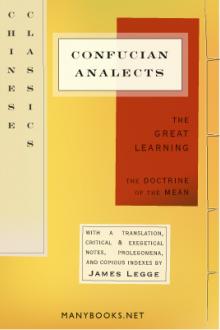Myths and Legends of China, E. Werner [best english novels for beginners TXT] 📗

- Author: E. Werner
Book online «Myths and Legends of China, E. Werner [best english novels for beginners TXT] 📗». Author E. Werner
Early Cosmogony Dualistic
The period before the appearance of the P’an Ku myth may be divided into two parts; that from some early unknown date up to about the middle of the Confucian epoch, say 500 B.C., and that from 500 B.C. to A.D. 400. We know that during the latter period the minds of Chinese scholars were frequently occupied with speculations as to the origin of the universe. Before 500 B.C. we have no documentary remains telling us what the Chinese believed about the origin of things; but it is exceedingly unlikely that no theories or speculations at all concerning the origin of themselves and their surroundings were formed by this intelligent people during the eighteen centuries or more which preceded the date at which we find the views held by them put into written form. It is safe to assume that the dualism which later occupied their philosophical thoughts to so great an extent as almost to seem inseparable from them, and exercised so powerful an influence throughout the course of their history, was not only formulating itself during that long period, but had gradually reached an advanced stage. We may even go so far as to say that dualism, or its beginnings, existed in the very earliest times, for the belief in the second self or ghost or double of the dead is in reality nothing else. And we find it operating with apparently undiminished energy after the Chinese mind had reached its maturity in the Sung dynasty. Page 84
The Canon of Changes
The Bible of Chinese dualism is the I ching, the Canon of Changes (or Permutations). It is held in great veneration both on account of its antiquity and also because of the “unfathomable wisdom which is supposed to lie concealed under its mysterious symbols.” It is placed first in the list of the classics, or Sacred Books, though it is not the oldest of them. When exactly the work itself on which the subsequent elaborations were founded was composed is not now known. Its origin is attributed to the legendary emperor Fu Hsi (2953–2838 B.C.). It does not furnish a cosmogony proper, but merely a dualistic system as an explanation, or attempted explanation, or even perhaps orly a record, of the constant changes (in modern philosophical language the “redistribution of matter and motion”) going on everywhere. That explanation or record was used for purposes of divination. This dualistic system, by a simple addition, became a monism, and at the same time furnished the Chinese with a cosmogony.
The Five Elements
The Five Elements or Forces (wu hsing)—which, according to the Chinese, are metal, air, fire, water, and wood—are first mentioned in Chinese literature in a chapter of the classic Book of History.6 They play a very important part in Chinese thought: ‘elements’ meaning generally not so much the actual substances as the forces essential to human, life. They have to be noticed in passing, because they were involved in the development of the cosmogonical ideas which took place in the eleventh and twelfth centuries A.D. Page 85
Monism
As their imagination grew, it was natural that the Chinese should begin to ask themselves what, if the yang and the yin by their permutations produced, or gave shape to, all things, was it that produced the yang and the yin. When we see traces of this inquisitive tendency we find ourselves on the borderland of dualism where the transition is taking place into the realm of monism. But though there may have been a tendency toward monism in early times, it was only in the Sung dynasty that the philosophers definitely placed behind the yang and the yin a First Cause—the Grand Origin, Grand Extreme, Grand Terminus, or Ultimate Ground of Existence.7 They gave to it the name t’ai chi, and represented it by a concrete sign, the symbol of a circle. The complete scheme shows the evolution of the Sixty-four Diagrams (kua) from the t’ai chi through the yang and the yin, the Four, Eight, Sixteen, and Thirty-two Diagrams successively. This conception was the work of the Sung philosopher Chou Tun-i (A.D. 1017–73), commonly known as Chou Tzŭ, and his disciple Chu Hsi (A.D. 1130–1200), known as Chu Tzŭ or Chu Fu Tzŭ, the famous historian and Confucian commentator—two of the greatest names in Chinese philosophy. It was at this time that the tide of constructive imagination in China, tinged though it always was with classical Confucianism, rose to its greatest height. There is the philosopher’s seeking for causes. Yet in this matter of the First Cause we detect, in the full flood of Confucianism, the potent influence of Taoist and Buddhist speculations. It has even been said that the Sung philosophy, which grew, not from the I ching itself, but from the appendixes to it, is more Taoistic than Confucian. As it was with the P’an Ku Page 86legend, so was it with this more philosophical cosmogony. The more fertile Taoist and Buddhist imaginations led to the preservation of what the Confucianists, distrusting the marvellous, would have allowed to die a natural death. It was, after all, the mystical foreign elements which gave point to—we may rightly say rounded off—the early dualism by converting it into monism, carrying philosophical speculation from the Knowable to the Unknowable, and furnishing the Chinese with their first scientific theory of the origin, not of the changes going on in the universe (on which they had already formed their opinions), but of the universe itself.
Chou Tzŭ’s “T’ai Chi T’u”
Chou Tun-i, appropriately apotheosized as ‘Prince in the Empire of Reason,’ completed and systematized the philosophical world-conception which had hitherto obtained in the Chinese mind. He did not ask his fellow-countrymen to discard





Comments (0)